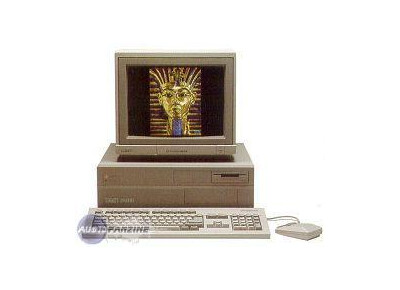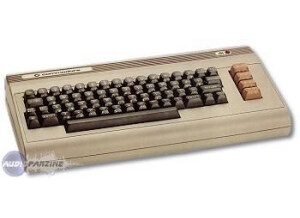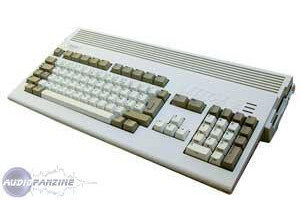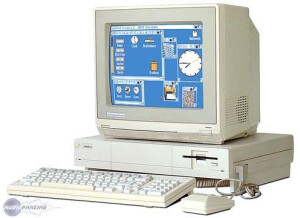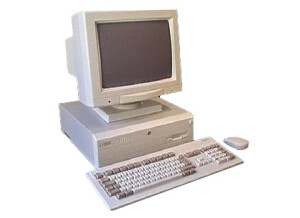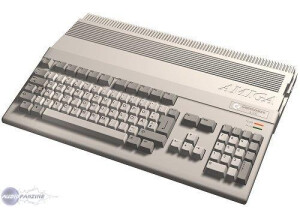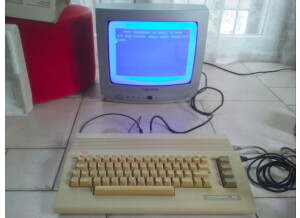Commodore Amiga 2000
- Mon ancien matos
- Mon matos actuel
- Mon futur matos
Fiche technique
- Fabricant : Commodore
- Modèle : Amiga 2000
- Catégorie : Autres Micro-ordinateurs
- Autres dénominations : amiga 2000, amiga2000, amiga 20 00, amiga20 00
Variants
A1500
A2000
A2000HD
A2500/020
A2500/030
A2500UX
In 1987 Commodore released its first highly expandable machine, the A2000. Early models are based around the A1000 design but most models are built around the A500 chip set. The A2000HD shipped with an A209x SCSI controller and a SCSI hard disk drive installed. The A2500 has a processor card added to the A2000HD configuration. The A1500 shipped with two floppy drives but no hard disk drive.
The A2500UX shipped with AT&T Unix System V Release 4 operating system instead of AmigaOS, a three button mouse, and usually with a tape streamer and Ethernet card.
68000 @ 7-28 MHz
68020 @ 7-25 MHz
68030 @ 16-50 MHz
68040 @ 25-40 MHz
68060 @ 50 MHz
The A1500 and A2000 have a socketed 68000 @ 7.14 MHz processor on their motherboard and they shipped with an empty processor slot. The A2500 use a processor card. The A2500/020 shipped with an A2620 processor card featuring a 68020 and 68881 @ 14 MHz, and the A2500/030 with an A2630 featuring a 68030 and 68882 @ 25 MHz.
Memoryup to 2 MB Chip RAM
up to 128 MB Fast RAM on processor cards
up to 8 MB Fast RAM on Zorro II expansion cards
Most A2000 models have 1 MB RAM soldered to their motherboard. Early models, the 3.x series, have 512 kB Chip RAM on their motherboard and 512 kB Fast RAM on their processor card. The 4.x series have both 512 kB Chip and Fast RAM soldered to their motherboard, whilst the 6.x series have their RAM set up as 1 MB Chip RAM. Chip RAM can be expanded to 2 MB with third party expansions which replace the Agnus chip.
24 bit Fast RAM can be added using Zorro II expansion cards up to 8 MB, and 32 bit Fast RAM using processor cards featuring a 68020 or better.
Agnus / Fat Agnus - OCS / ECS display controller
Denise / Super Denise - OCS / ECS display encoder
Paula - audio and I/O controller
Gary - system address decoder
Buster - DMA arbitrary controller
The A2000 OCS or ECS chip set offers the same screen modes as the A500 and A500 Plus:
| A500 | A500+ | |||||
|---|---|---|---|---|---|---|
| Low | High | Low | High | Super | ||
| PAL, non-interlaced PAL, interlaced NTSC, non-interlaced NTSC, interlaced |
320×256 320×512 320×200 320×400 |
640×256 640×512 640×200 640×400 |
320×256 320×512 320×200 320×400 |
640×256 640×512 640×200 640×400 |
1280×256 1280×512 1280×200 1280×400 |
50 Hz, 15.60 kHz 50 Hz, 15.60 kHz 60 Hz, 15.72 kHz 60 Hz, 15.72 kHz |
| Euro36 A2024 |
320×200 - 1280×400 1024×1024 |
73 Hz, 15.76 kHz 15 Hz, 15.72 kHz |
||||
| Multiscan Euro72 Super72 |
640×480 - 640×960 640×400 - 640×800 400×300 - 800×600 |
60 Hz, 31.44 kHz 70 Hz, 31.43 kHz 72 Hz, 24.62 kHz |
A2000s using the OCS chip set support either PAL or NTSC screen modes, not both.
Low resolution screen modes offer up to 32 colours from a palette of 4096, 64 in EHB mode or 4096 in HAM mode. High resolution screen modes offer 16 colours from 4096, super-high resolution and productivity modes offer 4 colours from a palette of 64. Other screen modes require a Zorro graphics card.
4 channel stereo 8 bit audio output with frequencies up to 28 kHz when using screen modes with 15 kHz, or up to 56 kHz when using screen modes with higher horizontal frequency. 16 bit audio requires a Zorro sound card.
A2000s with the OCS chip set shipped with Kickstart 1.2 first, later with 1.3. The ECS models all shipped with 2.04 Kickstart ROM. All versions can be replaced with a 3.1 one.
1× processor card slot (CPU slot)
5× Zorro II slots
1× video slot
2× inactive AT ISA slots
2× inactive XT ISA slots
The Zorro, ISA and video slots are all placed on the motherboard. Two AT ISA slots are in line with a Zorro II slot, while the XT and video slots are not.
In early A2000s the video slot just use the signals of the external 23 pin video connector, others are extended with the remaining digital video signals and some parallel port lines.
The four ISA slots have their power and ground pins activated only. In order to access the slots by the A2000 a BridgeBoard has to be installed. With an installed BridgeBoard, two or three ISA compatible cards can be used depending on the BridgeBoard's position - if it is installed in slot 3 two ISA and four Zorro cards can be used, if it is in slot 4 three ISA and three Zorro cards are possible. Inactive ISA slots can be used for non intelligent cards like TBCs or fan cards. The two XT ISA slots can be upgraded to AT slots by simply soldering the 16 bit extension slots.
Early A2000s implement an internal version of the A1000 external edge connector as processor card slot. All other revisions use a 86 pin processor card slot with a coprocessor interface which allows processor cards to be added without the need to remove the 68000.
The A2000 has a vast array of upgrade options, including processor cards, SCSI or IDE controllers, retargetable graphics cards, video digitizers, ethernet cards and many other types of expansion.
Drive bays2× 3.5" front bays
1× 5.25" front bay
In the A2000 one, in the A1500 both of the 3.5" bays are occupied with 880 kB double density floppy disk drives.
Interfaces1× serial DB25 male, RS232
1× internal serial 26 pin header
1× parallel DB25 female, Centronics
1× video DB23 male, analog RGB
1× composite, black & white
2× mouse/game DB9 male
2× stereo audio RCA jack
1× keyboard 5 pin DIN female
1× external floppy DB23 female
1× internal floppy 34 pin header
The floppy drive controller supports up to four devices - two attached to the internal floppy header and two connected to the external floppy port. Both double and high density disk drives are supported.
The internal serial header has the same address as the external one. It is intended to be used with internal MIDI interfaces.
A2000-A: (![]() )
)
It is based on the integration of the A1000 motherboard design and an example Zorro II backplane. It uses the thin Agnus (DIP) which handles only 512 kB RAM. The video slot is just an internal version of the external video port and the processor card slot is just an internal version of the A1000 external edge connector. The A2000-A has many reliability problems. The Buster chip is missing, so as the composite output connector. Memory is configured as 512 kB Chip RAM on motherboard and 512 kB Fast RAM in the processor slot.
A2000-B:
It is basically a cost reduced version based around the A500 chip set. Most of the control logic for the expansion bus is integrated into the Buster chip. The video slot is extended with more signals and the CPU slot has a coprocessor interface. A black and white composite video connector is provided. 1 MB of RAM is placed on the motherboard.
- revision 3.9
- pre-production A2000-B intended for demonstration purposes
- may have problems with processor cards as there is no additional buffering on the clocks that drive the CPU slot
- revision 4.0
- extra buffering splits Agnus clocks between the expansion and CPU slots
- rev 4.1
- correction of one missing signal on the video slot - no rev 4.0 boards were released because of this bug
- rev 4.2
- some unnecessary filter capacitors are removed to fix the character loss for HITEK type keyboards
- rev 4.3
- the Toshiba made Gary is replaced with a CSG (MOS) one, pull-up resistors added to support it
- rev 4.4
- changes in filtering of a noisy line, cost reduction
- rev 4.5 (
 )
) - fixes a problem in conjunction with expansion bus DMA turnaround
- uses Kickstart 1.3
- revision 5.0
- motherboard RAM use 256k×4 chips instead of 256k×1 ones
- revision 6.0
- some layout and FCC changes
- rev 6.1
- reset IC added to clean up RAM retention
- correction of the noise on the "time of day" clock
- uses Agnus 8372
- rev 6.2 (
 )
) - correction of the noise on the expansion bus caused by a new production of 68000s
- fix to get certain expansion boards to work correctly with 256k×4 DRAMs and Agnus 8372
- rev 6.5
- uses Kickstart 2.04 ROMs and the ECS chip set: Fat Agnus, Super Denise
220 W power output
2× standard 4 pin power connectors
2× mini 4 pin floppy drive power connectors
Avis utilisateurs
Monstrueux
Publié le 07/11/11 à 14:34J'ai jouté les A600 & A1200 à mon "pedigree" vu le nombre d'Amigas que j'ai fait adopté à l'époque du lycée!
A Gisors, on pouvait chercher les 520St: il n'y en avait pas/plus!
Les rares possesseurs avaient migré vers l'Amiga.
Mon 2000 s'est vu équipé au fur & à mesure d'un HD, d'une carte accelératrice 68030+68882 25Mhz.
Mon 1084 de 1987 était son écran de prédilection.

